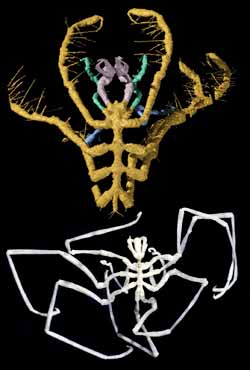Ancient sea spider fossils discovered in volcanic ash

A computer reconstruction of Haliestes (artificially colored, above), and a modern sea spider, Nymphon (bleached, below), which is about 50% larger, and with longer legs.
Volcanic ash that encased and preserved sea life in the Silurian age 425 million years ago near Herefordshire, UK has yielded fossils of an ancient sea spider, or pycnogonid, one of the most unusual types of arthropod in the seas today.
Sea spiders are soft-bodied arthropods, found widely in modern oceans. For two-centuries there has been a controversy about the relationship of sea spiders to land spiders, scorpions, ticks and mites because of their unique body form. Sea spiders have a long proboscis and unusual limb structures used in mating and carrying brooding embryos. The fossil record of their relationship is sparse because of their delicate nature.
“This is the earliest adult fossil example, and it is preserved in extraordinary detail,” said author Derek Briggs, professor of geology and geophysics, and Director of the Yale Institute of Biospheric Studies. “Volcanic ash that trapped ancient sea life in this location rapidly encased the creatures making a concrete-like cast of the bodies. The cavity later filled in with carbonate solids so we have a fossil record to study now.”
To create a picture of the fossils, the specimens were ground away a few microns at a time, each slice digitally imaged, and then the whole reconstructed using computer graphics. The reconstruction suggests that these exotic animals are indeed related to land spiders, scorpions, mites and ticks.
The new species, Haliestes dasos,, represents the earliest known adult sea spider by 35 million years. Its large pincers place the sea spiders firmly within a larger grouping that includes scorpions, mites, ticks, the real spiders and the horseshoe crab. Despite its ancient, Silurian age the new species appears to have lived in a similar way to modern ones, on the seabed, or perhaps on sponges.
The research was carried out as part of a project on the Herefordshire fauna by a team made up of Derek Siveter and Mark Sutton at Oxford, Derek Briggs at Yale, and David Siveter at Leicester. The group has made a number of other spectacular finds of soft-bodied organisms in the same deposit including crustaceans, a worm-like mollusc, a polychaete worm, and a starfish, and much that remains to be described.
Media Contact
More Information:
http://www.yale.eduAll latest news from the category: Life Sciences and Chemistry
Articles and reports from the Life Sciences and chemistry area deal with applied and basic research into modern biology, chemistry and human medicine.
Valuable information can be found on a range of life sciences fields including bacteriology, biochemistry, bionics, bioinformatics, biophysics, biotechnology, genetics, geobotany, human biology, marine biology, microbiology, molecular biology, cellular biology, zoology, bioinorganic chemistry, microchemistry and environmental chemistry.
Newest articles

Bringing bio-inspired robots to life
Nebraska researcher Eric Markvicka gets NSF CAREER Award to pursue manufacture of novel materials for soft robotics and stretchable electronics. Engineers are increasingly eager to develop robots that mimic the…

Bella moths use poison to attract mates
Scientists are closer to finding out how. Pyrrolizidine alkaloids are as bitter and toxic as they are hard to pronounce. They’re produced by several different types of plants and are…

AI tool creates ‘synthetic’ images of cells
…for enhanced microscopy analysis. Observing individual cells through microscopes can reveal a range of important cell biological phenomena that frequently play a role in human diseases, but the process of…





















